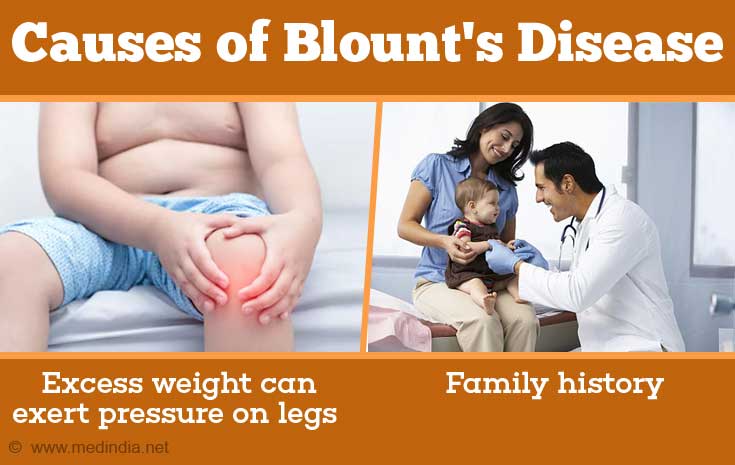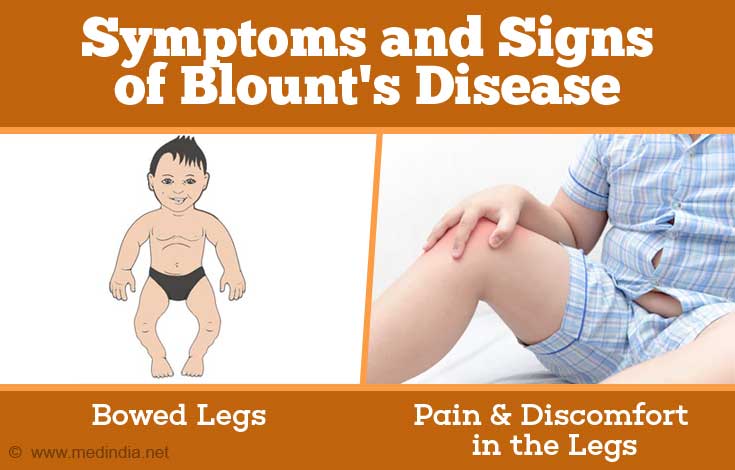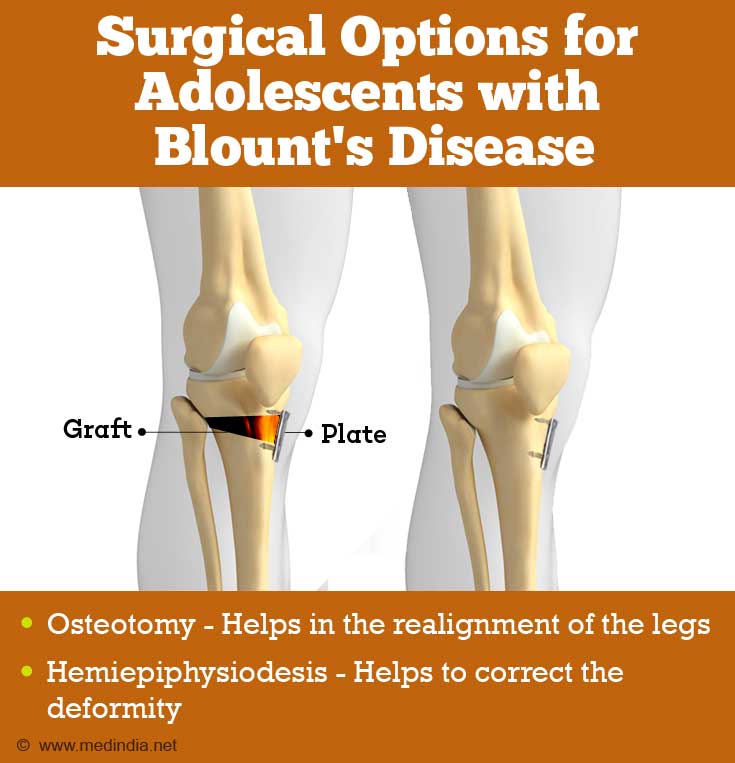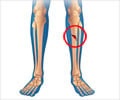- blount Disease - Genetic and rare Disease Information Center (GArD), National Center for Advancing Translational Sciences, National Institutes of Health, USA - (https://rarediseases.info.nih.gov/diseases/916/blount-disease)
- blount’s Disease - Johns Hopkins Medicine - (https://www.hopkinsmedicine.org/healthlibrary/conditions/orthopaedic_disorders/blounts_disease_22,blountsDisease)
- blount Disease - Teens Health from Nemours - (https://kidshealth.org/en/teens/blount-disease.html)
- bowed Legs (blount’s Disease) - OrthoInfo (American Academy of Orthopedic Surgeons) - (https://orthoinfo.aaos.org/en/diseases--conditions/bowed-legs-blounts-disease/)
- birch JG. blount disease. J Am Acad Orthop Surg. 2013 Jul; 21(7): 408-18. : DOI:10.5435/JAAOS-21-07-408. PMID: 23818028.
- bowleg Deformity (blount’s Disease) - Hospital for Special Surgery (HSS) - (https://www.hss.edu/conditions_bowleg-deformity-blounts-disease.asp)
- blount Disease - radiopaedia - (https://radiopaedia.org/articles/blount-disease)
What is Blount's Disease?
Blount’s disease is a developmental disorder affecting the top portion of the shinbone (tibia), which leads to progressive lower leg deformity resulting in bowed legs (genu varum). Normal (physiological) bowing that occurs in babies improves with age and resolves within 2 years of age. However, bowing in Blount’s disease does not improve and gets worse with age. This disease is also called tibia vara and is characterized by differential growth of the physis (region of growth or growth plate), which is not able to take the load from the upper part of the body. Growth of the physis occurs in the lateral (outer) aspect, but not is the medial (inner) aspect. As a result, the lower portion of the leg bows outwards, which can lead to leg length discrepancy.
Origin of the Term "Blount's Disease"
The disease is named after Walter Putnam Blount, an American pediatric orthopedic surgeon, who first described the disease in 1937.
Epidemiology of Blount's Disease
The National Institutes of Health (NIH) has classified Blount’s disease as a rare disease. This is because it affects less than 1% of the U.S. population, where the disease has been studied most intensively. The disease is more prevalent in obese children and children of African and Hispanic ancestry.
What are the Types of Blount's Disease?
Blount’s disease can be categorized into two types:
- Infantile Blount’s Disease: This is also called early-onset Blount’s disease and is 5 times more common than the adolescent form of the disease. It is prevalent in children below 4 years of age and its incidence is more in boys than in girls and is more common in early walkers. Approximately 50% of patients suffer from bilateral Blount’s disease and the deformity occurs in the tibia only.
- Adolescent Blount’s Disease: This is also called late-onset Blount’s disease and occurs in children above 10 years of age. It is less common than the infantile form and is more likely to manifest as unilateral Blount’s disease. The deformity typically occurs in both the femur (thigh bone) and tibia.
An intermediate form – called Juvenile Blount’s disease – has been suggested, which includes children between the ages of 4-10 years.
What are the Causes of Blount's Disease?
The exact cause of Blount’s disease is not clearly understood. However, some possible causes have been suggested,including the following:
Childhood Obesity: Children who are obese or exhibit rapid weight gain have a tendency to develop this disease, as greater pressure is exerted at the physis of the tibia.- Early Walking: Infants who start to walk at an earlier age (usually < 1 year) are more susceptible to developing the disease.
- Ancestry: People of African and Hispanic descent are more susceptible to developing the disease.
- Heredity: The disease can be inherited by autosomal dominant inheritance. A child who has a family member with Blount’s disease is more likely to inherit the disease.

What are the Symptoms & Signs of Blount's Disease?
Some of the common symptoms and signs are briefly highlighted below:
- Bowed Legs: This is the most conspicuous symptom, also known as genu varum, which can occur in one leg or both legs. This is most evident when a child stands up and exhibits an awkward walking pattern.
- Intoeing (Pigeon-toed): This refers to the turning of the feet and is quite common, often occurring in combination with bowed legs. Intoeing can cause frequent tripping of the child.
- Pain & Discomfort: If untreated, prolonged bowing can cause pain and discomfort in the joints of the legs, such as the hips, knees and/or ankles, particularly in adolescent patients. This is due to the abnormal stress exerted by the deformed legs on these joints.

How do you Diagnose Blount's Disease?
Diagnosis of Blount’s disease is done in 3 steps. These involve a medical history of the patient, followed by a physical exam and X-ray.
- Medical History: A detailed medical history will be taken, particularly to trace if there is a family history of the disease.
- Physical Exam: The orthopedic surgeon will carefully examine the child to assess the condition. This is particularly important for differentiating Blount’s disease from physiological bowing.
- X-Ray: The doctor may order an X-Ray to confirm the diagnosis. This is carried out in a standing position, which produces an image of the hips, legs and ankles together, showing the degree of alignment. The X-ray will clearly show the deformity in minute detail and reveal the severity of the condition. Based upon the radiological findings, the surgeon will decide on the treatment strategy to be adopted.
How do you Treat Blount's Disease?
Treatment usually involves bracing and/or surgery. These are briefly highlighted below:
- Bracing: Braces are long-legged metallic assistive devices that help to minimize the load on the knees. These need to be worn while walking and during weight-bearing. Braces can be used for infantile Blount’s disease as a conservative therapy. If detected early, bracing alone will be sufficient to control the disease. However, bracing is not beneficial for adolescents with Blount’s disease.
- Surgery: Surgery is aimed at stopping further worsening of the condition and preventing permanent damage to the growth area of the tibia. This is the treatment of choice for adolescents with Blount’s disease. Two types of surgery may be performed:
Osteotomy : This is the most common type of surgery that is carried out on the tibia, accompanied by realignment of the lower leg. The surgeon cuts the tibia as close as possible to the growth plate and realigns the bone.- Hemiepiphysiodesis: In this procedure, the surgeon cuts through the skin and muscle tissue to expose the tibia and places plates or staples on the lateral side of the growth plate to prevent growth on that side. The plates guide the growth of the leg in a straightened alignment. This procedure takes time to correct the deformity. Following the surgery, a fixator may be placed on the leg to maintain proper alignment during the healing process.

What is the Prognosis for Blount's Disease?
The outlook is best in case of early diagnosis and treatment, either by bracing or surgery. Bracing is usually less beneficial in girls and in obese children. However, in case of a successful surgery, no residual deformity or disability will be present, thereby greatly improving the prognosis.







